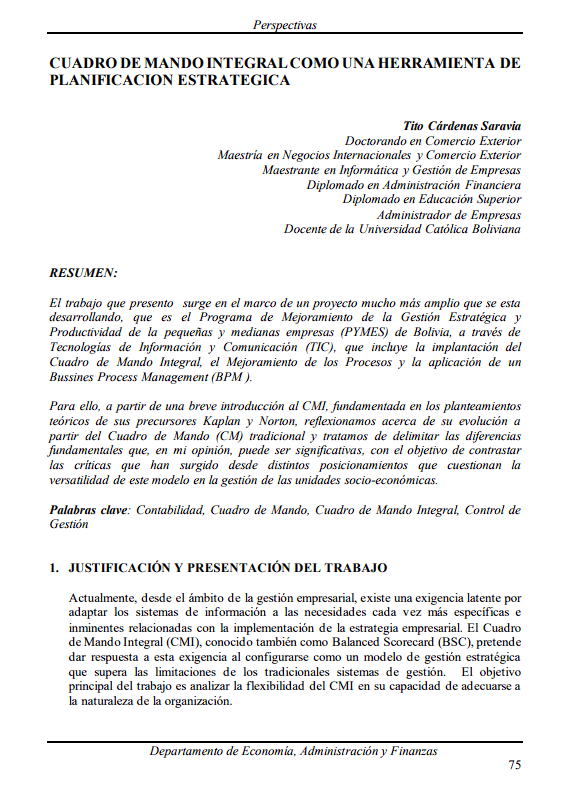Balanced scorecard as a tool for strategic planning.
DOI:
https://doi.org/10.35319/52hnnd15Keywords:
Accounting, Scorecard, Balanced Scorecard, Management ControlAbstract
The work I present arises within the framework of a much broader project currently underway, which is the Program for the Improvement of Strategic Management and Productivity of small and medium enterprises (SMEs) in Bolivia, through Information and Communication Technologies (ICT), including the implementation of the Balanced Scorecard, Process Improvement, and the application of Business Process Management (BPM).
For this, based on a brief introduction to the BSC, grounded in the theoretical frameworks of its pioneers Kaplan and Norton, we reflect on its evolution from the traditional Scorecard (SC) and try to outline the fundamental differences which, in my opinion, can be significant, with the goal of contrasting the criticisms that have arisen from different perspectives questioning the versatility of this model in the management of socio-economic units.
Downloads
References
Álvarez López, J. (1998). Integración del Balanced Scorecard y la EFQM en la teoría de los Stakeholders. Boletín AECA, N° 46, marzo-junio.
Amat Salas, O., Hernández, J. M., Fontrodona, J. y Fontana, I. (2001). El cuadro de mando integral y el crecimiento empresarial. Partida Doble, N° 126, octubre.
Blázquez, M. (2000). Uso y abuso del Balanced Scorecard.
Butler, A., Letza, S. R. y Neale, B. (1997). Linking the Balanced Scorecard to Strategy. Long Range Planning, vol. 30, N° 2, pp. 242-253.
Dávila, A. (1999). Nuevas herramientas de control: el Cuadro de Mando Integral. Revista de Antiguos Alumnos IESE, p. 36.
Escobar Rodríguez, T. (1999). El papel del cuadro de mando en la gestión estratégica de la empresa. Revista Española de Financiación y Contabilidad, vol. XXVIII, N° 102.
Falguera Martínez-Alarcón, J. (2002). La contabilidad de gestión en los centros sanitarios. Tesis doctoral, Universitat Pompeu Fabra, junio.
Kaplan, R. S. y Norton, D. P. (1997). Cuadro de mando integral. Barcelona: Gestión 2000.
Kaplan, R. S. y Norton, D. P. (2000). The Strategy-Focused Organization: How Balanced Scorecard Companies Thrive in the New Business Environment. Boston: Harvard Business School.
Lauzel, P. y Cibert, A. (1967). De los ratios al cuadro de mando. Francisco Casanovas Editor.
López Viñegla, A. (2001). El Balanced Scorecard y el cuadro de mando como herramientas complementarias: Un análisis diferenciado. Revista Gestión, N° 22, p. 10.
Sanin Vilar, A. (1998). El control de gestión en los objetivos de la empresa. Harvard Deusto Finanzas & Contabilidad, N° 22.

Downloads
Published
Issue
Section
License
Copyright (c) 2007 Revista Perspectivas

This work is licensed under a Creative Commons Attribution-NonCommercial-ShareAlike 4.0 International License.
La Revista Perspectivas de la Universidad Católica Boliviana, es una revista de acceso abierto, por lo tanto, es de libre acceso en su integridad. Está permitida su lectura, búsqueda, descarga, distribución y reutilización legal en cualquier tipo de soporte únicamente para fines no comerciales, siempre y cuando la obra sea debidamente citada.




